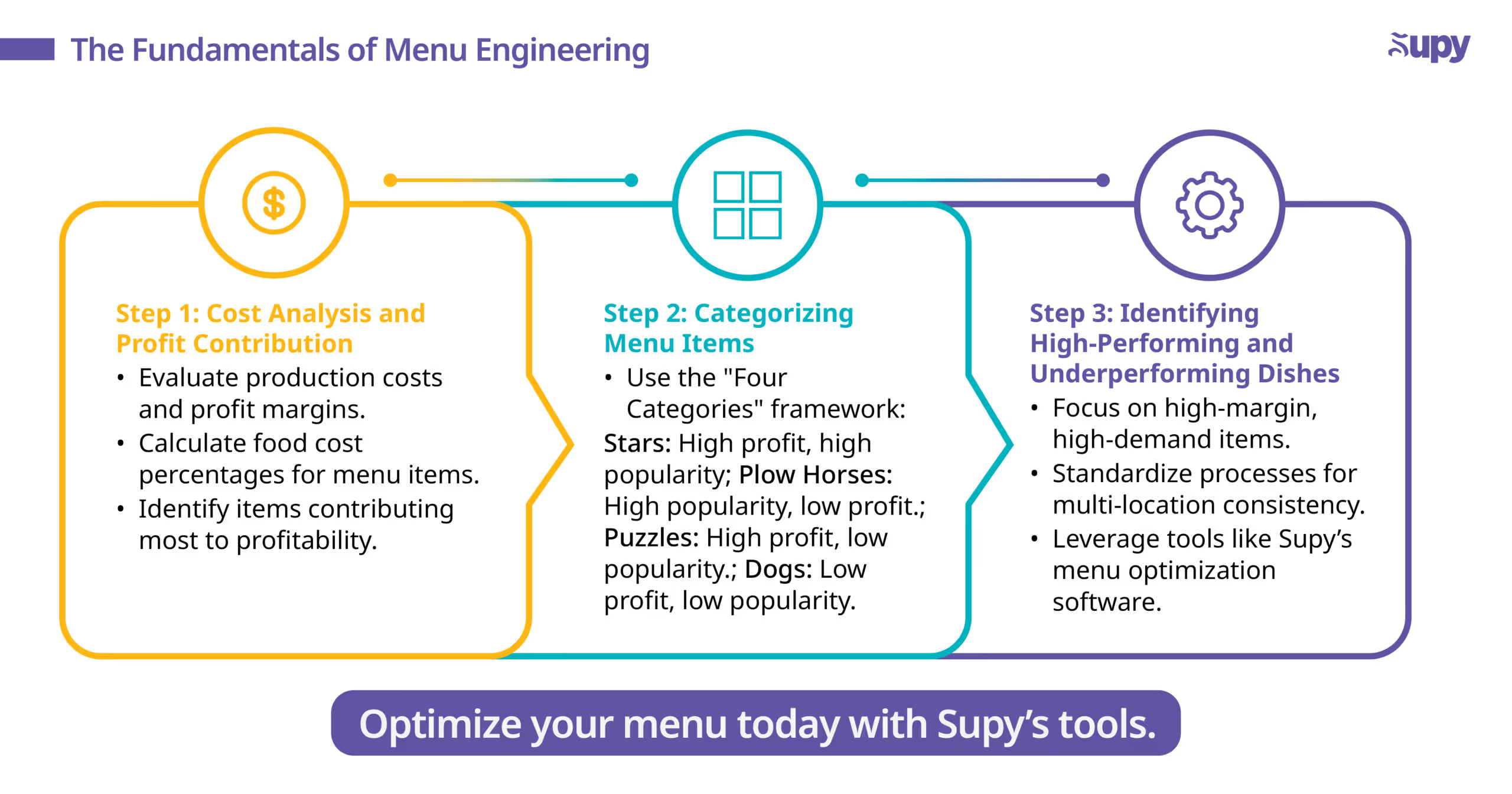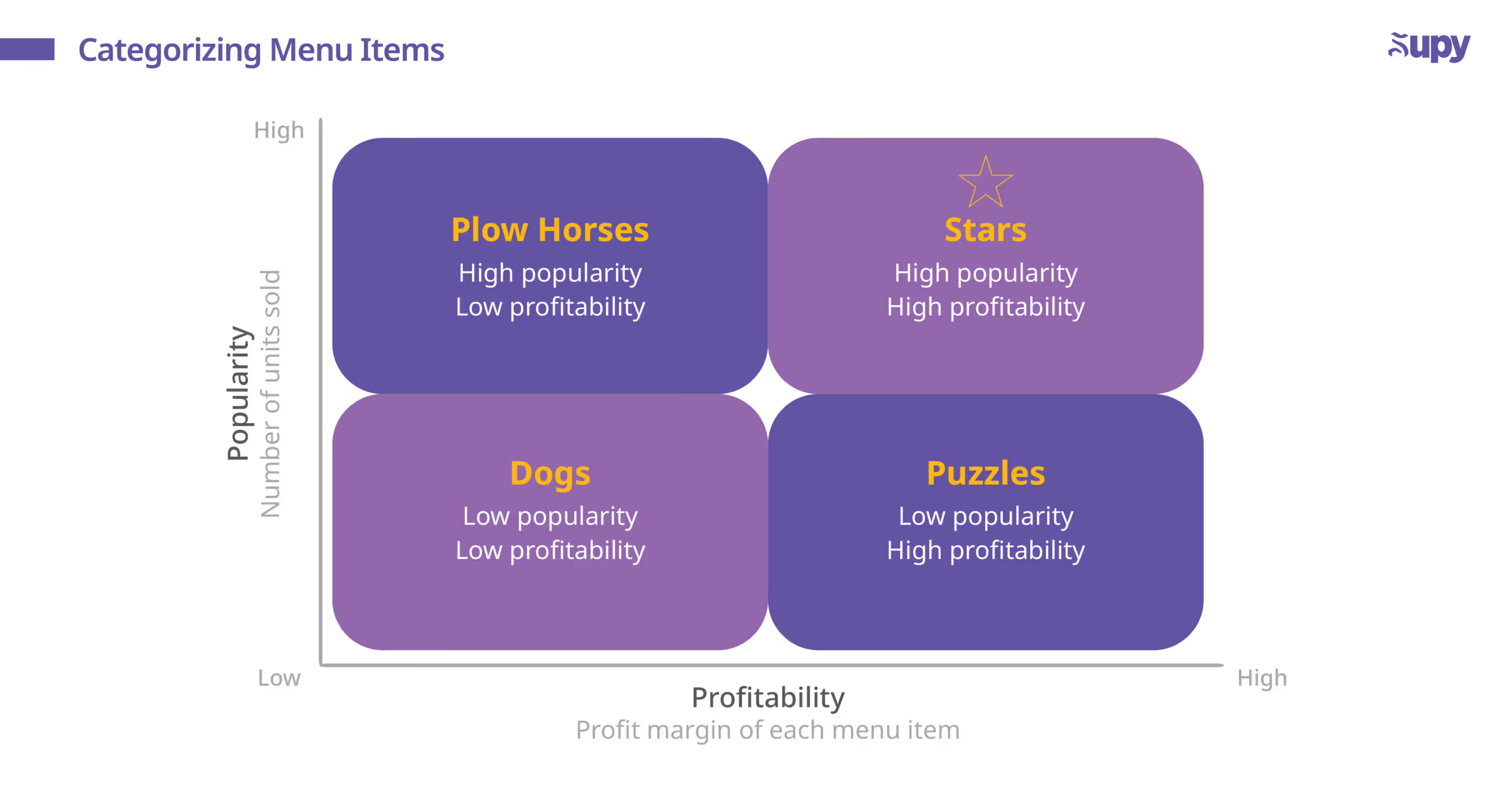Mastering Multi-Location Menu Engineering to Maximize Profits

In the restaurant world, menu engineering refers to the process of strategically designing, analyzing, and pricing a restaurant’s menu to maximize its profitability. Indeed, by optimizing items, pricing strategies, and menu layout, menu engineering plays a pivotal role in driving consistent revenue growth for multi-location restaurants. After all, a well-engineered menu can be a powerful subliminal tool for influencing customers' orders!
Yet the process of managing menus across multiple locations can be quite tricky. For one thing, maintaining consistency across the chain is a big concern, since it can be hard to maintain uniform offerings and prices across each of your locations. It’s also important to consider things like cost control, especially in diverse markets where ingredients and operational costs may differ. Last but not least, catering to each branch’s local tastes (while also maintaining a cohesive brand identity) can also pose a serious menu engineering challenge.
- The Fundamentals of Menu Engineering
- Standardizing Your Menu While Adapting to Local Tastes
- Using Menu Analytics to Drive Profitability
- Controlling Costs Through Ingredient Standardization
- Designing Menus for Smoother Workflows
- Measuring Success Through Real-Time Insights
- Successful Real-Life Example
- Conclusion
- About Supy
With Supy’s multi-branch restaurant menu engineering services, we hope to help you simplify the process. Not only does our platform allow for real-time updates and centralized menu control; but it also helps track your food costs, optimizes your prices, and analyzes your previous sales data to help you make informed decisions.
Read on to learn how Supy holds the key to menu engineering that maximizes your profits!
1. The Fundamentals of Menu Engineering

As previously mentioned, menu engineering forms a key part of restaurant optimization. In this section, we’ll go over the fundamentals of menu engineering to get you up to speed.
Step 1: Cost Analysis and Profit Contribution
This preliminary part of menu engineering encourages restaurant owners and managers to evaluate each item on their menu for its cost of production and corresponding profit margin. This includes understanding your ingredients, their total prep time, and any associated overhead costs. By calculating the food cost percentage of each item and evaluating how it contributes to your overall profitability, restaurant operators can identify which items on the menu are bringing in the most revenue.
Step 2: Categorizing Menu Items

During the categorization process, your menu items will often be categorized into four main categories:
- Stars: These items have high profitability and high popularity.
- Plow Horses: These items have high popularity but low profitability.
- Puzzles: These items have low popularity but high profitability.
- Dogs: These items have low popularity and low profitability.
Categorizing your menu like this can help management prioritize high-performing items while reevaluating or removing dishes that aren't performing too well.
Step 3: Identifying High-Performing and Underperforming Dishes
The purpose of menu engineering is to focus on high-margin, high-demand dishes and remove or adjust any low-performing ones. This is easy enough to do if you only have one location, but what happens in a multi-location operation?
Standardizing these elements can be incredibly complex for multi-location chains, since each location may have different customer preferences. That’s where implementing technology like Supy’s menu optimization tools can help you ensure consistency across each of your locations. With data-driven insights and streamlined workflows, Supy enables operators to effectively apply these fundamentals across their entire chain, maximizing profitability while simultaneously simplifying menu management.
2. Standardizing Your Menu While Adapting to Local Tastes
In multi-location restaurant operations, it’s of the utmost importance to maintain a consistent brand identity while simultaneously adapting your brand to local customer preferences.
One effective strategy to do this is to create a core menu that aligns with the brand’s identity and is consistently offered across all locations. This core menu should feature signature items that reflect the restaurant's values, whether it’s a unique burger recipe or a signature dish. Meanwhile, each location can adapt to regional preferences by offering limited-time local specials or variations of signature items tailored to the tastes of specific areas.
For example, a burger chain may have a globally recognized menu but introduce regional burgers, like a spicy chili burger in Texas or a fish burger in coastal areas, catering to local preferences.
3. Using Menu Analytics to Drive Profitability
In multi-location restaurant operations, leveraging your analytics to check your menu performance is key. These analytics tools allow operators to dive right into the data of running their business–identifying key trends, pricing opportunities, and item placement strategies that can make a significant impact on their bottom line! By analyzing factors like sales volume and customer preferences, operators can identify high-performing items on their menu and thus adjust their offerings in accordance.
One major advantage of centralized management is the ability to simplify decision-making across multiple locations. By putting all your relevant metrics and insights in one place, restaurant managers can ensure consistency in pricing, item placement, and promotions across each of their sites. This makes sure that each location is aligned with the brand’s broader profitability goals.
Take, for instance, the example of a café chain using Supy's menu engineering tools. By analyzing sales data from each of its locations, the chain identified its high-margin items and put them in a more visible place on the menu. The cafe also used menu analytics to tailor promotions for its high-cost, low-demand items, thus maximizing its sales during peak times!
4. Controlling Costs Through Ingredient Standardization
Next, standardizing your ingredients across multiple restaurant locations is a highly effective strategy for controlling your food costs. By using the same ingredients for similar menu items, restaurant chains can:
- Reduce waste
- Achieve better pricing on bulk orders
- Minimize discrepancies between locations.
- Lowers ingredient costs
All these practices help maintain the quality of food, ensuring that each location serves the same high-quality dishes!
For example, a pizza chain sourcing a single cheese supplier across all locations has a better chance of delivering the same taste and quality across each of its locations. By committing to a long-term contract with a supplier, the chain can also benefit from bulk pricing, lower delivery costs, and stable ingredient availability.
5. Designing Menus for Smoother Workflows
It may come as a surprise to learn that effective menu design goes beyond just appealing to customers’ tastes; it also plays a key role in streamlining your kitchen operations! By carefully engineering their menus, restaurants can keep things running smoothly in the kitchen by reducing prep time and optimizing staff productivity.
One of the first steps to achieving operational efficiency through menu design is to evaluate how each of your dishes is prepared. If you can find a way to do overlapping steps for several dishes at the same time, you can significantly reduce the risk of developing bottlenecks during peak kitchen hours. For instance, by eliminating menu items that require the same cooking equipment or ingredients, you can significantly speed up service in your restaurant!
Many advanced software tools on the market allow you to visualize your kitchen workflows, while also suggesting new potential layout optimizations. This can help reduce back-and-forth movement in the kitchen, thus minimizing the time required for each order to move from prep to plate.
6. Measuring Success Through Real-Time Insights
In the fast-paced world of multi-location restaurant management, your restaurant can never afford to slip. Indeed, the key to staying competitive and maximizing profits is continuous improvement. That’s why real-time monitoring and tracking are an essential feature of Supy’s menu engineering software.
Supy’s dynamic dashboards and POS systems are designed to provide a clear overview of each item’s performance and any associated customer preferences in real time. This allows restaurant owners and managers to easily track which menu items are performing well and which ones may need adjustments, allowing them to continuously tweak and optimize their menus. Whether it’s dynamic pricing strategies, introducing new items, or removing underperforming dishes, these real-time insights enable faster, more effective decision-making.
Moreover, Supy’s software is designed to consolidate your data from each and every one of your locations so that you can have a holistic view of trends across your entire brand; a level of visibility that is invaluable for making informed, scalable decisions.
7. Successful Real-Life Example
For a successful example of the transformative effects of Supy’s centralized data management systems for multi-location chains, look no further than Grit Hospitality, the brains behind some of the UAE’s favorite brands.
With three booming brands (Tahini, WiseGuys, and Moonshine) under its name that all offered different kinds of cuisines, each Grit Hospitality establishment required active involvement from top management to stay on track. Their outdated pen-and-paper processes got in the way of timely analysis and prompt action, while the tedious Excel spreadsheet method of record keeping was often met with human error, delays in delivery, and hidden discrepancies.
Since its brands often shared the same ingredients, Grit Hospitality also recognized the need to aggregate their orders to reduce their food costs. With Supy’s help, the entire procurement process was digitized from top to bottom, enabling the mass ordering of ingredients and thus reducing overall ingredient prices. Manual data entry processes were also eliminated to make the management process more efficient.
In this episode of Supy Talks Podcast, the Managing Patner of Grit Hospitality Riad Abou Lteif discusses the process behind launching successful restaurant concepts:
https://www.youtube.com/watch?v=eFqp5wi4OpU
8. Conclusion
In conclusion, mastering multi-location menu engineering is a game-changer for restaurant operators looking to maximize their profits. This is because not only does it help streamline your operations–menu engineering can also help you maintain consistency and quality across your restaurant chain!
At Supy, we understand the challenges that come with managing multi-location restaurant operations. That’s why our platform is designed to streamline menu engineering by providing you with powerful tools for data-driven insights, inventory optimization, and real-time reporting.
But don’t just take our word for it! Subscribe to Supy’s newsletter for exclusive expert tips and best practices for running a successful restaurant business. You can even schedule a free demo to learn more about Supy's menu engineering tools and techniques.
For more about how retail execution software can best serve you and your business, click here!
9. About Supy
Supy is the best restaurant inventory management software platform tailored for multi-branch restaurants and franchises. With features like real-time inventory tracking, smart procurement systems, and advanced analytics, Supy helps restaurants manage their various demands effectively and provides the tools restaurants need to thrive in a dynamic industry.
For the latest expert insights, download Supy’s ebook: The Ultimate Guide to Reducing Food Costs in Multi-Branch & Enterprise Restaurants.
Ready to find out more? Schedule a demo with Supy today and take the first step towards a streamlined, profitable future.






